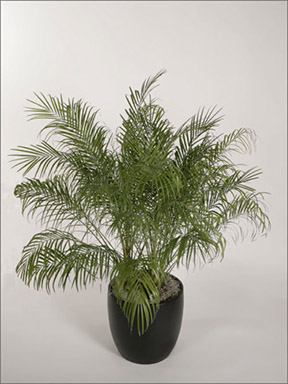Common Name: Date palm
Light Needs
Medium to high light
Water Requirements
Water thoroughly
Description:
Phoenix roebelenii have gracefully arching, feathery fronds radiating from the center of sturdy trunks.
Most commonly used varieties: Miniature date palm, pygmy date palm and Phoenix palm.
Phoenix roebelenii have gracefully arching, feathery fronds radiating from the center of sturdy trunks. Grown as single or multiple-trunked plants. Palms have unique botanical features setting them apart from other interiorscape plants. Palms do not have a distinct xylem and phloem, but possess a series of vascular bundles randomly scattered throughout the trunk tissue that translocate food and water. This arrangement makes it difficult to use systematics or implants for pest control.
Palms lack cambium cells necessary for lateral growth. Maturing trunks thicken only through diffuse lateral growth, a process by which vascular bundles form and overlap repeatedly, slowly increasing the girth by sheer mass. Palms do not develop and outer layer or corky bark. The hardened out trunk cells offer little protection and can be easily damaged. Phoenix palms are monocots and cannot develop lateral or side branches. All growth originates from the apical bud at the terminal tip of the trunk. Cutting or damaging this growth point spells death for the plant. Phoenix palms have pinnately compound leaf fronds. The leaflets on older fronds develop into modified spines on the lower part of the rachis. Though bothersome, these sharp spines perform several important functions. The spines protect the delicate ‘heart’ of the palm from damage by predators. They also help maintain humidity levels around the tender palm heart by directing moisture from rain and condensation down the spine and into the center of the plant.
Though Phoenix roebelenii can be acclimated to light levels as low as 100fc, they do best in 200fc or above – even tolerating direct sun. Unfortunately, higher light levels usually mean lower humidity levels – a condition Phoenix protest by developing brown tips. Remedy this by grouping Phoenix with other plants to increase humidity.
Thoroughly water entire root ball, then allow to dry sufficiently. In medium light (100fc – 250fc), allow media to dry down one-third of container; in higher light conditions, allow to dry down three inches to one-third of container. Overwatering symptoms start with yellow foliage and then progress to entire fronds that collapse and wilt. Roots develop rot and entire plant declines rapidly. Underwatering symptoms start with brown tips that progress to entire fronds turning brown and collapsing. The dense root system makes it difficult for water to penetrate into the center of the root ball, so water dry media carefully.
Phoenix palms have extensive fleshy root systems that store water. Plant will decline rapidly if overwatered in low light conditions. Low humidity causes brown tips on fronds. Clean frond regularly for healthy growth. Remove dust by spraying both sides of fronds with a commercial leaf cleaning product approved for use with palms or a mixture of 1 tsp phosphate-free dish soap in 1 qt water. Add 1 tsp of alcohol to the mixture to remove tough grime or honeydew from insect pests. Clean older, spiny fronds by spraying until runoff, then allowing the frond to ‘drip dry.’ Older fronds at the base of the plant die naturally as new fronds emerge from the terminal growth tip. Trim old fronds closely, allowing the petiole to remain attached to the trunk. The fibrous petiole stubs help protect tender trunk tissue from harm. Brown or yellow tps on the pinnae are signals from the plant that all is not well.
Phoenix are susceptible to scale, mealybug, thrips and spider mites. Closely examine areas where infestations might develop such as the underside of fronds, cracks and crevices on the trunk or the whorl of new growth arising from center of the palm. Pick off scale and mealybug with an alcohol-soaked cotton swab. Wipe or spray both sides of fronds with a soapy mixture to control mites and thrips. If these measures do not work, try a low toxicity, interiorscape approved pesticide such a Safer’s Soap.



